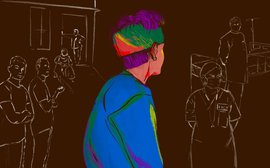The sound of bagpipes in a remote village in Uttarakhand is rather rare and unusual. Here we were, listening to them in Baijnath in Bageshwar district, with drums playing in sync. In the distance, we could also hear high-pitched voices singing, interspersed with laughter and clapping. We arrived at what appeared to be a festival, but was in fact a local wedding. We could now see the faces of those playing the instruments. The musicians also danced and sang. Dressed in vibrant colours, the performers used shields and swords, and danced in pairs. In weddings here, the local community follows the procession, and the bride rides on a horse till the wedding hall.
This is the Choliya dance and it originates in the Kumaon region of Uttarakhand. No women participate, it is a dance of warriors. Influences of the British Raj and Rajput culture are visible in the bagpipes and swords they use. Choliya as an art form is a confluence of music and performance that is over a thousand years old.
The drummers, known as dholies are predominantly Dalits, while the other musicians are from a mix of castes, but mainly Rajputs. The performance sets a celebratory tone for the wedding. People still believe that Choliya has the power to ward off evil spirits and protect the couple from ill-luck.


